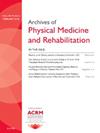阿尔茨海默病和相关痴呆患者的家庭健康入院来源和发作时间不同4367
IF 3.6
2区 医学
Q1 REHABILITATION
Archives of physical medicine and rehabilitation
Pub Date : 2025-04-01
DOI:10.1016/j.apmr.2025.01.011
引用次数: 0
摘要
目标阿尔茨海默病及相关痴呆症(ADRD)患者在获得急性期后护理服务时会遇到很大的障碍。2020 年,医疗保险实施了一种新的家庭医疗付款模式,即患者驱动分组模式 (PDGM)。PDGM 令 ADRD 患者担忧,因为它严重依赖入院来源和发作时间。患者权益组织认为,PDGM 阻碍了医疗机构接收来自社区(相对于机构环境)且只需要一次护理的患者。家庭医疗已被推荐为预防 ADRD 患者住院的一种策略,并且已被证明在护理频率更高、持续时间更长的情况下是有效的。根据 PDGM 进行补偿似乎与这一需求相冲突。为了确定 PDGM 是否改变了 ADRD 患者的就医和使用模式,我们将 PDGM 的组成部分应用于 2019 年的家庭医疗数据,旨在描述基线数据。参与者根据患者人口统计学特征、护理人员支持、认知状态、先前功能状态、先前医疗保健使用情况和 Charlson 合并症评分,对 153957 名患有和未患有痴呆症的患者创建了两组倾向得分匹配组.干预措施无.主要结果测量使用二元逻辑回归来检验 ADRD 与入院来源之间的关系。负二项回归用于检验 ADRD 与晚期发作次数之间的关系。采用对数单变量回归来检验 ADRD 与所提供服务数量之间的关系。结果患有 ADRD 的患者入住社区的几率要高出 1.095(95% 置信区间,1.083-1.109)。就逾期发作次数而言,ADRD 患者的估计平均值为 1.62 次,而 ADRD 患者为 1.53 次(P< .0001)。患有 ADRD 的患者接受更多服务的几率比没有 ADRD 的配对患者高 1.081。结论在实施 PDGM 之前,患有 ADRD 的患者比没有 ADRD 的匹配患者更有可能从社区进入家庭医疗机构,有更多的后期发作,接受更多的服务。两组患者的总费用没有临床意义上的差别。本文章由计算机程序翻译,如有差异,请以英文原文为准。
Home Health Admission Source and Episode Timing Differ for People with Alzheimer's Disease and Related Dementias 4367
Objectives
People with Alzheimer's disease and related dementias (ADRD) experience significant barriers to accessing postacute care services. In 2020, Medicare implemented a new home health payment model, known as the Patient Driven Grouping Model (PDGM). The PDGM is concerning for people with ADRD because of it is heavy reliance on admission source and timing of episodes. Patient advocacy groups believe the PDGM disincentivizes agencies from admitting individuals who come from the community (vs an institutional setting) and require >1 episode of care. Home health has been recommended as a strategy to prevent hospitalizations for people with ADRD and has been shown to be effective with more frequent and longer durations of care. Reimbursement under the PDGM appears be in conflict with this need. To determine if the PDGM has altered access and utilization patterns of people living with ADRD, we aimed to describe baseline data by applying components of the PDGM to 2019 home health data.
Design
Retrospective analysis of 100% of Medicare beneficiaries receiving home health care in 2019.
Setting
Home health care.
Participants
Two propensity score-matched groups of 153,957 individuals with and without dementia were created based on patient demographics, caregiver support, cognitive status, prior functional status, prior health care utilization, and Charlson comorbidity scores.
Interventions
None.
Main Outcome Measures
A binary logistic regression was used to examine the relationship between ADRD and admission source. A negative binomial regression was used to examine the relationship between ADRD and the number of late episodes. Univariate regression with logit was used to examine the relationship between ADRD and the number of services provided. A gamma-distributed log link model was used to estimate the mean total charges.
Results
Individuals with ADRD had 1.095 greater odds (95% confidence interval, 1.083-1.109) of community admission. For the number of late episodes, individuals with ADRD had an estimated mean of 1.62 compared with 1.53 (P<.0001). Individuals with ADRD had 1.081 greater odds of receiving more services than their matched peers without ADRD. The difference in the estimated means for total charges between individuals with ADRD and those without ADRD was $24.00 (P<.0001).
Conclusions
Prior to the implementation of the PDGM, individuals with ADRD were more likely to be admitted to home health from the community, have more late episodes, and receive more services than their matched peers without ADRD. There was not a clinically meaningful difference in total charges between the 2 groups.
Supported by NIA KO1AG073538.
Disclosures
none.
求助全文
通过发布文献求助,成功后即可免费获取论文全文。
去求助
来源期刊
CiteScore
6.20
自引率
4.70%
发文量
495
审稿时长
38 days
期刊介绍:
The Archives of Physical Medicine and Rehabilitation publishes original, peer-reviewed research and clinical reports on important trends and developments in physical medicine and rehabilitation and related fields. This international journal brings researchers and clinicians authoritative information on the therapeutic utilization of physical, behavioral and pharmaceutical agents in providing comprehensive care for individuals with chronic illness and disabilities.
Archives began publication in 1920, publishes monthly, and is the official journal of the American Congress of Rehabilitation Medicine. Its papers are cited more often than any other rehabilitation journal.

 求助内容:
求助内容: 应助结果提醒方式:
应助结果提醒方式:


